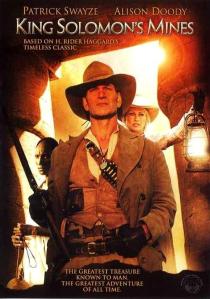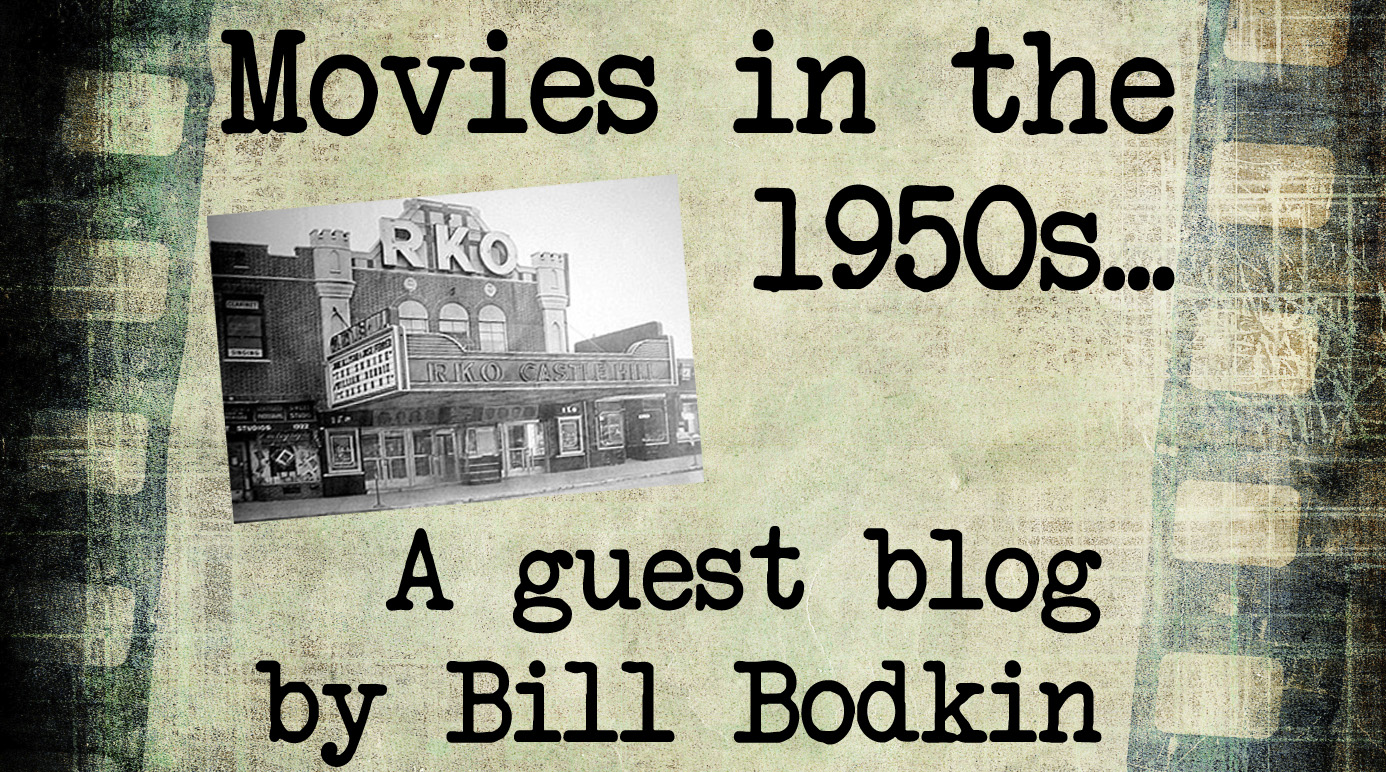bill bodkin’s father weighs in on his favorite films of the eisenhower era …
When I was asked to write a review on my favorite movies of the 50’s, I thought that would be fun.
So the first thing I did was to get a list of the top 100 movies of the 50’s. I perused the list and said to myself, “There’s a lot of good stuff on this list”. I was in a quandary as to what to do. As I again looked at the list, I thought I have to categorize these because there is no way to do justice to this list by just picking 10 or even 15 movies. So I decided to categorize the movies by Epic, Action, Drama, Animated, Musical (I will comment on this subject a little later) and Foreign.
There were 25 foreign films mentioned in the Top 100. Some French, some Italian, one Indian and the rest were Japanese. I knew I couldn’t review many of these because the only movies I saw were Seven Samurai, which later was adapted to become the Magnificent Seven in 1960 with a cowboy theme, Rashomon and Scrooge, aka A Christmas Carol.
I also realized that there were several classics I did not see, so I can not review them but you should know what they are. They are: On The Waterfront (1954), A Streetcar Named Desire (1951), Rebel Without A Cause (1955), Touch Of Evil (1958), East Of Eden (1955), Room At The Top (1959) and lastly, A Place In The Sun (1951).
The main reason I didn’t see most of these was I was too young and didn’t really want to watch a drama. I was into action movies: war, adventure, cowboys and gangsters, but they are considered by many as American film classics and need to be recognized.
As I was deciding which movie to start my reviews, I realized that my favorite all-time movie was not on the list and neither was my second or third.My second favorite movie, Winchester ’73 also made me aware of something else that I think you should be aware of. Maybe some of you know that back “in the day” (boy, do I hate that expression), there were only two major purveyors of movies: RKO and Loew’s. Now, there were other movie theaters, but they showed the movies that already played at either the RKO of Loews.
When you went to the theate, there always was a double feature. A double feature consisted of feature movie and a “B” movie, and these were shown in one theater. The theaters back then — especially the first run — usually had a balcony, a children’s section off to the side a smoking and non-smoking section, and there was usually a firebreak after the 15th row. The movie houses also employed ushers and usherettes who would help you find a seat. The theaters were pretty classy, too., Murals on the walls, curtains, sconces and they were kept immaculate. When I have gone back to see my old theaters, I find they have been basically dismantled so they can show multiple movies at any one time in any of the mini theaters within the theater, and they have zero ambiance.
Back then, Hollywood would produce 104 movies per year — 52 to be shown at the RKO and 52 at the Loews. I remember it used to cost 25cents for kids and 35 cents for adults. For this price, you got to see a feature film, a news reel, coming attractions (trailers) and a cartoon or two or just a short subject plus the “B” movie, which was sometimes better than the “A” — not often but sometimes. On Saturdays at the second-run theaters for 16 cents starting at 9:30 a.m., you would see three movies, 10 cartoons or more, coming attractions and serials.
You were in there until 5:00 p.m. Those were the days your younger brothers and sisters were most likely conceived.
To get back to why Winchester ’73 reminded me of all the above was because after the movies, they had a buckboard, an old cowboy term for an uncovered wagon, with a real Winchester that you could feel, hold and play with until the kid behind you started to whine. Now when my mother and father went to the movies, they were given dishes so that if you went often enough, you could have a whole set for the family.
Some of you who are used to the multiplex theaters of now are maybe wondering how those theater s make any money just by showing a new movie every eek. Well, not many of us had TV’s back then, and the movies was the prime source of family entertainment. Our first TV had an 8-inch round screen. Only black and white and all stations went off at midnight, playing the National Anthem — boy, what a ruckus that would cause among some of the people in this country now — followed by the station call letters being displayed with an almost a low-humming sound. TV would start up at 6:00 a.m. in the major cities, again with the National Anthem, followed by the first show, which was usually the news.
Let’s see: I think I’ve given you enough history, so now let me tell you my top three movies. Wait I said I would tell you why I put musicals in its own class. Well, the last musical I saw in the theater was Mama Mia, and prior to that was West Side Story back in 1961. Again, because we had no television, musicals were very popular. When TV first started out, they had variety shows that offered singing, dancing and comedy and they were very popular. Now, the closest thing you get to a variety show is Leno or Letterman or the news on CNN — shows you were my politics lie.
Finally, my top three movies were King Solomon’s Mines, Winchester ’73and The Quiet Man. King Solomon’s Mines, the 1950 version with Stewart Granger, Deborah Kerr and Richard Carlson, is still my No. 1. The other two are still favorites and within my Top 20.
Why King Solomon’s Mines? It was the first movie I was allowed to go to by myself, and I saw it in the Loew’s American which was in Parkchester in The Bronx, N.Y. This was a beautiful theatre. Rugs on all the floors and stairs, there was a balcony and plenty of seating room. Scones on the walls with what I believe were Persian rugs — it’s been a very long time.
The movie was in Technicolor — not all movies were — and it was 100 minutes long. It won two Oscars — one for editing and the other for cinematography (now I know what that is) and it was up for best picture.
The movies was based loosely on the novel by H. Rider Haggard. I say loosely because the only things that were in the movie and in the book were the names Alan Quartermain, John Goode, the family name Curtis, Umbopa, the Watusi tribe and the treasure itself. Be that as it may, the color and photography was/still is magnificent, especially of the animals, the scenery and the colors of the jewels in the treasure.
Stewart Granger was Alan Quartermain a African Hunter of renown who is asked to take Deborah Kerr, plying Elizabeth Curtis, and her brother John Goode, played by Richard Carlson, to find her long lost husband, Henry Curtis, who was following a map he found in Cape Town. Quartermain refuses because he believes it’s a wild goose chase, especially going into uncharted territory and he refuses to go on safari with a woman. She is able to change his mind by promising him 5,000 pounds whether or not they find her husband or she decides to turn back. The money she tells him will set up his young sons education in England.
I’m not going to tell you the rest of the story, but I will tell you that it’s very well acted, there is plenty of action and you will see a cast of thousands, and they aren’t CGI either, and the color is spectacular. The scenes from this movie can almost be found in any later edition of a Tarzan movie or any jungle movie. ( I just found out the desert scenes were filmed White Sands, N.M., and the cave scenes in Carlsbad National Park in New Mexico, but the rest in various African locations.)

There have been four other versions of King Solomon’s Mines produced. One in 1937 starting Paul Robeson, another in 1985 with Richard Chamberlain, an animated version in 1986, and a TV version starring the late Patrick Swayze in 2004. I have seen them all … don’t waste your time, and I have read the book. I really enjoyed the book, which I first read bout 20 years ago, and it ranks amongst my favorites also.
It is also so different than what was put on the silver screen, but it’s a good adventure novel. Just a fact about the book: Rider was going to sell it to the publisher for 500 pounds, but a the last minute demanded 10-percent royalties which they agreed to and that set him up for life.
This movie is pure escapism, so rent it and sit back and enjoy. Hope you enjoyed the read. If so, tell your friends and I will review more of the movies of the ’50s, ’60s, ’70s, as well as the music of the ’50s, ’60s and ’70s.







First thanks to the editor for finding the pictures that he added. It really added to the story. Second tell the writer to use spell check, he spelt playing wrong.
Otherwise it was a brilliant piece.
OOnRmA http://gdjI3b7VaWpU1m0dGpvjRrcu9Fk.com